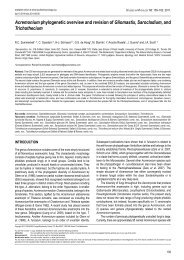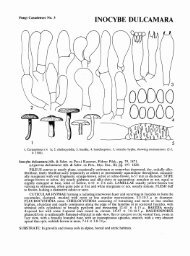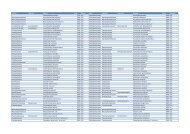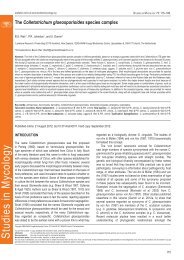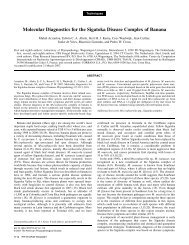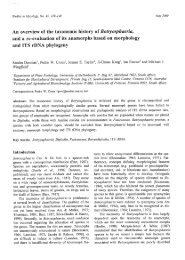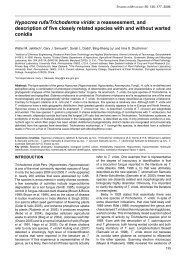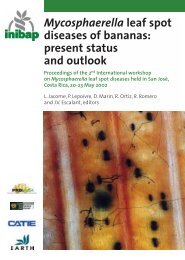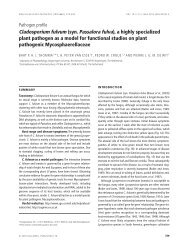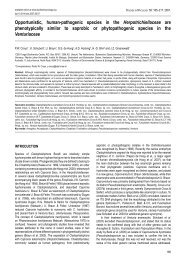Phylogenetic lineages in the Capnodiales - Cbs - KNAW
Phylogenetic lineages in the Capnodiales - Cbs - KNAW
Phylogenetic lineages in the Capnodiales - Cbs - KNAW
You also want an ePaper? Increase the reach of your titles
YUMPU automatically turns print PDFs into web optimized ePapers that Google loves.
for numerous stra<strong>in</strong>s. Although some of <strong>the</strong>se <strong>in</strong>sertions were<br />
anticipated based on data already present <strong>in</strong> GenBank’s database,<br />
<strong>the</strong> <strong>in</strong>sertions <strong>in</strong> <strong>the</strong> LSU were not expected based on <strong>the</strong> sequences<br />
used for primer design. However, this could be a result of <strong>the</strong> fewer<br />
complete LSU sequences available <strong>in</strong> <strong>the</strong> database ra<strong>the</strong>r than a<br />
deviation on <strong>the</strong> part of members of <strong>the</strong> <strong>Capnodiales</strong>. More complete<br />
LSU sequences are needed from diverse orders to test whe<strong>the</strong>r<br />
this is <strong>the</strong> case or not. Some of <strong>the</strong> taxa sequenced dur<strong>in</strong>g this<br />
study had <strong>in</strong>sertions present at almost all of <strong>the</strong> possible <strong>in</strong>sertion<br />
positions, e.g. Mycosphaerella latebrosa, Septoria quercicola and<br />
Teratosphaeria mexicana. These taxa are distributed throughout<br />
<strong>the</strong> tree, and do not only cluster <strong>in</strong> a basal position, and <strong>the</strong>refore it<br />
is difficult to predict why so many <strong>in</strong>sertions were present. If <strong>the</strong>se<br />
<strong>in</strong>sertions were all present <strong>in</strong> a basal position, it would have been<br />
possible to argue that <strong>the</strong> higher number of <strong>in</strong>sertions represents<br />
<strong>the</strong> ancestral condition, and that <strong>the</strong>se <strong>in</strong>sertions are lost dur<strong>in</strong>g<br />
evolution. However, this proved not to be <strong>the</strong> case, and it could be<br />
that <strong>the</strong>se taxa accumulated <strong>the</strong>se <strong>in</strong>sertions.<br />
Although <strong>the</strong> present study adds significantly to our knowledge<br />
of <strong>the</strong> <strong>Capnodiales</strong>, <strong>the</strong> Capnodiaceae are still underrepresented,<br />
and probably consist of numerous diverse <strong>l<strong>in</strong>eages</strong> that can<br />
be elevated to family level once our phylogenies become more<br />
resolved. Regardless of this fact, <strong>the</strong> Mycosphaerellaceae clade<br />
appears to be quite robust. It seems likely that fur<strong>the</strong>r sampl<strong>in</strong>g of<br />
<strong>the</strong> diverse Teratosphaeriaceae will necessitate fur<strong>the</strong>r taxonomic<br />
changes. The fact that <strong>the</strong> saprobic and plant pathogenic and<br />
endophytic modes have evolved several times <strong>in</strong> different<br />
families, suggest that many taxa can still easily adapt to chang<strong>in</strong>g<br />
environments. A focus on add<strong>in</strong>g more lichenicolous taxa, and taxa<br />
occurr<strong>in</strong>g on non-plant substrates is crucial to provide fur<strong>the</strong>r <strong>in</strong>sight<br />
<strong>in</strong>to <strong>the</strong> ecological adaptations occurr<strong>in</strong>g <strong>in</strong> <strong>the</strong> <strong>Capnodiales</strong>.<br />
ACKNOwleDGeMeNTs<br />
Several colleagues have helped to collect material studied here, without which this<br />
work would not have been possible. Drs E.H.C. Mckenzie and S.R. Pennycook<br />
(Landcare New Zealand) are specifically thanked for recollect<strong>in</strong>g Phaeophleospora<br />
atk<strong>in</strong>sonii. We are grateful to BIOTEC and Dr Lily Eurwilaichitr (Director, Bioresources<br />
unit, BIOTEC) for assist<strong>in</strong>g with a collection trip <strong>in</strong> Thailand under <strong>the</strong> collaborative<br />
BIOTEC-CBS memorandum of understand<strong>in</strong>g. We thank Miss Marjan Vermaas for<br />
prepar<strong>in</strong>g <strong>the</strong> photographic plates, and M. Star<strong>in</strong>k-Willemse, and A. van Iperen, for<br />
assistance with DNA sequenc<strong>in</strong>g and fungal cultures. Work performed for this paper<br />
by <strong>the</strong> second author after 2008 was supported <strong>in</strong> part by <strong>the</strong> Intramural Research<br />
Program of <strong>the</strong> NIH, National Library of Medic<strong>in</strong>e. Before 2008 work was funded by<br />
a grant from NSF (DEB-0717476). We are grateful to Drs Roland Kirschner, Alan J.<br />
Phillips and Treena I. Burgess for <strong>the</strong>ir critical comments on this script. The views<br />
expressed, however, are those of <strong>the</strong> authors.<br />
ReFeReNCes<br />
Andjic V, Barber PA, Carnegie AJ, Hardy GEStJ, W<strong>in</strong>gfield MJ, Burgess TI (2007).<br />
<strong>Phylogenetic</strong> reassessment supports accommodation of Phaeophleospora<br />
and Colletogloeopsis from eucalypts <strong>in</strong> Kirramyces. Mycological Research 111:<br />
1184–1198.<br />
Aptroot A (2006). Mycosphaerella and its Anamorphs: 2. Conspectus of<br />
Mycosphaerella. CBS Biodiversity Series 5, Utrecht, The Ne<strong>the</strong>rlands.<br />
Arnold RH (1971). Melanodothis caricis, n. gen., n. sp. and “Hyalodothis? caricis”.<br />
Canadian Journal of Botany 49: 2187–2196.<br />
Arzanlou M, Crous PW (2006). Phaeosphaeriopsis musae. In: Fungal Planet – A<br />
Global Initiative to promote <strong>the</strong> Study of Fungal Biodiversity (Crous PW, Seifert<br />
KA, Samson RA, Hawksworth DL eds). CBS, Utrecht, Ne<strong>the</strong>rlands. Fungal<br />
Planet No. 9.<br />
Arzanlou M, Crous PW, Groenewald JZ (2008a). Devriesia strelitziae. In: Fungal<br />
Planet – A Global Initiative to promote <strong>the</strong> Study of Fungal Biodiversity (Crous<br />
PW, Seifert KA, Samson RA, Hawksworth DL eds). CBS, Utrecht, Ne<strong>the</strong>rlands.<br />
Fungal Planet No. 22.<br />
www.studies<strong>in</strong>mycology.org<br />
<strong>Phylogenetic</strong> l<strong>in</strong>eageS <strong>in</strong> <strong>the</strong> <strong>Capnodiales</strong><br />
Arzanlou M, Groenewald JZ, Fullerton RA, Abeln ECA, Carlier J, et al. (2008b).<br />
Multiple gene genealogies and phenotypic characters differentiate several<br />
novel species of Mycosphaerella and related anamorphs on banana. Persoonia<br />
20: 19–37.<br />
Arzanlou M, Groenewald JZ, Gams W, Braun U, Sh<strong>in</strong> H-D, Crous PW (2007).<br />
<strong>Phylogenetic</strong> and morphotaxonomic revision of Ramichloridium and allied<br />
genera. Studies <strong>in</strong> Mycology 58: 57–93.<br />
Auld BA (1969). Incidence of damage caused by organisms which attack crofton<br />
weed <strong>in</strong> <strong>the</strong> Richmond-Tweed region of New South Wales. Australian Journal<br />
of Science 32: 163.<br />
Barr ME (1987). Prodomus to class Loculoascomycetes. Published by <strong>the</strong> author,<br />
Amherst, Massachusetts.<br />
Batzer JC, Gleason ML, Harr<strong>in</strong>gton TC, Tiffany LH (2005). Expansion of <strong>the</strong> sooty<br />
blotch and flyspeck complex on apples based on analysis of ribosomal DNA<br />
gene sequences and morphology. Mycologia 97: 1268–1286.<br />
Batzer JC, Mercedes Diaz Arias M, Harr<strong>in</strong>gton TC, Gleason ML, Groenewald JZ,<br />
Crous PW (2007). Four species of Zygophiala (Schizothyriaceae, <strong>Capnodiales</strong>)<br />
are associated with <strong>the</strong> sooty blotch and flyspeck complex on apple. Mycologia<br />
100: 246–258.<br />
Beilharz V, Pascoe I (2002). Two additional species of Verrucisporota, one with a<br />
Mycosphaerella teleomorph, from Australia. Mycotaxon 82: 357–365.<br />
Beld<strong>in</strong>g RD, Sutton TB, Blankenship SM, Young E (2000). Relationship between<br />
apple fruit epicuticular wax and growth of Peltaster fructicola and Leptodontidium<br />
elatius, two fungi that cause sooty blotch disease. Plant Disease 84: 767–772.<br />
Bess HA, Haramoto FH (1958). Biological control of pamakani, Eupatorium<br />
adenophorum, <strong>in</strong> Hawaii by a tephritid gall fly, Procecidochares utilis. 1. The life<br />
history of <strong>the</strong> fly and its effectiveness <strong>in</strong> <strong>the</strong> control of <strong>the</strong> weed. In: Proceed<strong>in</strong>gs<br />
of <strong>the</strong> Tenth International Congress of Entomology, Vol. 4 (Becker EC, ed.).<br />
Canada, Ottawa, Mortimer: 543–548.<br />
Bonifaz A, Badali H, Hoog GS de, Cruz M, Araiza J, et al. (2008). T<strong>in</strong>ea nigra by<br />
Hortaea werneckii, a report of 22 cases from Mexico. Studies <strong>in</strong> Mycology 61:<br />
77–82.<br />
Braun U, Crous PW, Dugan F, Groenewald JZ, Hoog GS de (2003). Phylogeny and<br />
taxonomy of Cladosporium-like hyphomycetes, <strong>in</strong>clud<strong>in</strong>g Davidiella gen. nov.,<br />
<strong>the</strong> teleomorph of Cladosporium s.str. Mycological Progress 2: 3–18.<br />
Braun U, Crous PW, Schubert K (2008). Taxonomic revision of <strong>the</strong> genus<br />
Cladosporium s. lat. 8. Re<strong>in</strong>troduction of Graphiopsis (= Dichocladosporium)<br />
with fur<strong>the</strong>r reassessments of cladosporioid hyphomycetes. Mycotaxon 103:<br />
207–216.<br />
Carnegie AJ, Keane PJ (2003). Variation <strong>in</strong> severity of target spot, caused by<br />
Aulograph<strong>in</strong>a eucalypti, <strong>in</strong> a eucalypt species and provenance trial <strong>in</strong> Victoria.<br />
Australasian Plant Pathology 32: 393–402.<br />
Cheewangkoon R, Crous PW, Hyde KD, Groenewald JZ, To-anan C (2008). Species<br />
of Mycosphaerella and related anamorphs on Eucalyptus leaves from Thailand.<br />
Persoonia 21: 77–91.<br />
Cheewangkoon R, Groenewald JZ, Summerell BA, Hyde KD, To-anun C, Crous PW<br />
(2009). Myrtaceae, a cache of fungal biodiversity. Persoonia 23: 55–85.<br />
Cort<strong>in</strong>as M-N, Burgess T, Dell D, Xu D, Crous PW, W<strong>in</strong>gfield BD, W<strong>in</strong>gfield MJ<br />
(2006b). First record of Colletogloeopsis zuluense comb. nov., caus<strong>in</strong>g a stem<br />
canker of Eucalyptus <strong>in</strong> Ch<strong>in</strong>a. Mycological Research 110: 229–236.<br />
Cort<strong>in</strong>as M-N, Crous PW, W<strong>in</strong>gfield BD, W<strong>in</strong>gfield MJ (2006a). Multi-gene<br />
phylogenies and phenotypic characters dist<strong>in</strong>guish two species with<strong>in</strong> <strong>the</strong><br />
Colletogloeopsis zuluensis complex associated with Eucalyptus stem cankers.<br />
Studies <strong>in</strong> Mycology 55: 133–146.<br />
Crous PW (1998). Mycosphaerella spp. and <strong>the</strong>ir anamorphs associated with leaf<br />
spot diseases of Eucalyptus. Mycologia Memoir 21: 1–170.<br />
Crous PW (2009). Taxonomy and phylogeny of <strong>the</strong> genus Mycosphaerella and its<br />
anamorphs. Fungal Diversity 38: 1–24.<br />
Crous PW, Aptroot A, Kang JC, Braun U, W<strong>in</strong>gfield MJ (2000). The genus<br />
Mycosphaerella and its anamorphs. Studies <strong>in</strong> Mycology 45: 107–121.<br />
Crous PW, Braun U (2003). Mycosphaerella and its anamorphs. 1. Names published<br />
<strong>in</strong> Cercospora and Passalora. CBS Biodiversity Series 1: 1–571.<br />
Crous PW, Braun U, Groenewald JZ (2007a). Mycosphaerella is polyphyletic.<br />
Studies <strong>in</strong> Mycology 58: 1–32.<br />
Crous PW, Braun U, Schubert K, Groenewald JZ (2007b). Delimit<strong>in</strong>g Cladosporium<br />
from morphologically similar genera. Studies <strong>in</strong> Mycology 58: 33–56.<br />
Crous PW, Denman S, Taylor JE, Swart L, Palm ME (2004a). Cultivation and<br />
diseases of Proteaceae: Leucadendron, Leucospermum and Protea. CBS<br />
Biodiversity Series 2: 1–228.<br />
Crous PW, Ferreira FA, Sutton BC (1997). A comparison of <strong>the</strong> fungal genera<br />
Phaeophleospora and Kirramyces (coelomycetes). South African Journal of<br />
Botany 63: 111–115.<br />
Crous PW, Gams W, Stalpers JA, Robert V, Stegehuis G (2004b). MycoBank: an<br />
onl<strong>in</strong>e <strong>in</strong>itiative to launch mycology <strong>in</strong>to <strong>the</strong> 21st century. Studies <strong>in</strong> Mycology<br />
50: 19–22.<br />
Crous PW, Groenewald JZ, Mansilla JP, Hunter GC, W<strong>in</strong>gfield MJ (2004c).<br />
<strong>Phylogenetic</strong> reassessment of Mycosphaerella spp. and <strong>the</strong>ir anamorphs<br />
occurr<strong>in</strong>g on Eucalyptus. Studies <strong>in</strong> Mycology 50: 195–214.<br />
45




